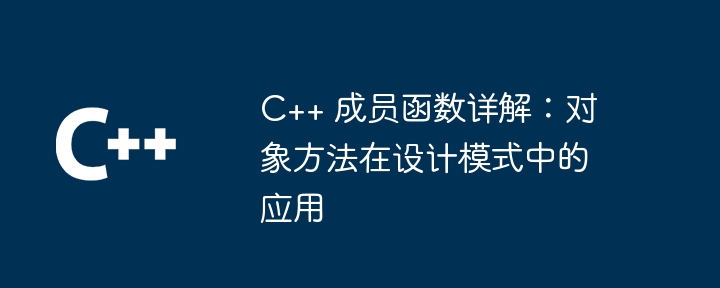Home >Backend Development >C++ >Detailed explanation of C++ member functions: application of object methods in design patterns
Detailed explanation of C++ member functions: application of object methods in design patterns
- WBOYWBOYWBOYWBOYWBOYWBOYWBOYWBOYWBOYWBOYWBOYWBOYWBOriginal
- 2024-04-29 11:09:02548browse
The application of C member functions in design patterns includes: encapsulating data, avoiding duplication of code and improving testability. In practical cases, the factory pattern is implemented through member functions: the abstract product interface defines common behaviors, specific product classes implement specific behaviors, the factory creates products based on types, and customers use member functions to create and use products.

C Detailed explanation of member functions: Application of object methods in design patterns
Introduction
In object-oriented programming, member functions are an important part of object methods. They allow an object to perform specific tasks or access its internal data. This article will take an in-depth look at member functions in C and demonstrate their critical role in design patterns through practical examples.
Basics of member functions
Member functions are methods defined inside a class that can directly access objects and their members. They are declared according to the following syntax:
returnType className::functionName(parameterList) {
// 函数体
}- returnType: The return value type of the function.
- className: The class that defines the function.
- functionName: The name of the function.
- parameterList: The parameter list of the function.
- Function body: The implementation of the function.
Member function types
Member functions can have different types, including:
- Constructor: Used to create objects.
- Destructor: Used to release the resources occupied by the object.
- Access function (getter/setter): Used to get or set object member variables.
- Ordinary functions: Used to implement the business logic of the object.
Object methods in design patterns
Object methods play a vital role in design patterns, especially in the following aspects:
- Encapsulated data: Member functions can access the private data of the object, thereby ensuring data encapsulation.
- Avoid duplication of code: Extracting common behaviors into member functions can avoid writing duplicate code in different classes.
- Improve testability: Member functions can be tested individually, simplifying the code debugging process.
Practical case: Factory pattern
Factory pattern is a design pattern for creating objects. Let us use a C practical case to show the application of member functions in the factory pattern:
// 抽象产品接口
class Product {
public:
virtual void doSomething() = 0;
};
// 具体产品类
class ConcreteProduct1 : public Product {
public:
void doSomething() override {
// 实现具体行为
}
};
// 具体产品类
class ConcreteProduct2 : public Product {
public:
void doSomething() override {
// 实现具体行为
}
};
// 工厂类,负责创建不同类型的产品
class Factory {
public:
Product* createProduct(const string& type) {
if (type == "Product1") {
return new ConcreteProduct1();
} else if (type == "Product2") {
return new ConcreteProduct2();
} else {
return nullptr;
}
}
};
// 客户类,使用工厂创建产品
class Client {
public:
void useProduct(const string& type) {
Factory factory;
Product* product = factory.createProduct(type);
product->doSomething();
delete product;
}
};
int main() {
Client client;
client.useProduct("Product1");
client.useProduct("Product2");
return 0;
}In this example:
- Product is an abstract product interface that defines common behavior.
- ConcreteProduct1 and ConcreteProduct2 are concrete product classes that implement their respective behaviors.
- Factory class Factory is responsible for creating product objects according to the given type.
- Client class Client uses factories to create and use different types of products.
Member functions play a vital role in the factory pattern:
- The doSomething() member functions of ConcreteProduct1 and ConcreteProduct2 implement the behavior of specific products .
- The createProduct() member function in the Factory class creates the corresponding product object based on the type.
- The Client class uses the member function useProduct() to create and use products.
Conclusion
C member functions provide a powerful and flexible way to encapsulate behavior and data in object methods. Through this article's in-depth discussion of the basics, types, and application of member functions in design patterns, we further understand their importance in object-oriented programming.
The above is the detailed content of Detailed explanation of C++ member functions: application of object methods in design patterns. For more information, please follow other related articles on the PHP Chinese website!

